Shihao Zhao
MiniMax-Remover: Taming Bad Noise Helps Video Object Removal
May 30, 2025Abstract:Recent advances in video diffusion models have driven rapid progress in video editing techniques. However, video object removal, a critical subtask of video editing, remains challenging due to issues such as hallucinated objects and visual artifacts. Furthermore, existing methods often rely on computationally expensive sampling procedures and classifier-free guidance (CFG), resulting in slow inference. To address these limitations, we propose MiniMax-Remover, a novel two-stage video object removal approach. Motivated by the observation that text condition is not best suited for this task, we simplify the pretrained video generation model by removing textual input and cross-attention layers, resulting in a more lightweight and efficient model architecture in the first stage. In the second stage, we distilled our remover on successful videos produced by the stage-1 model and curated by human annotators, using a minimax optimization strategy to further improve editing quality and inference speed. Specifically, the inner maximization identifies adversarial input noise ("bad noise") that makes failure removals, while the outer minimization step trains the model to generate high-quality removal results even under such challenging conditions. As a result, our method achieves a state-of-the-art video object removal results with as few as 6 sampling steps and doesn't rely on CFG, significantly improving inference efficiency. Extensive experiments demonstrate the effectiveness and superiority of MiniMax-Remover compared to existing methods. Codes and Videos are available at: https://minimax-remover.github.io.
Señorita-2M: A High-Quality Instruction-based Dataset for General Video Editing by Video Specialists
Feb 10, 2025



Abstract:Recent advancements in video generation have spurred the development of video editing techniques, which can be divided into inversion-based and end-to-end methods. However, current video editing methods still suffer from several challenges. Inversion-based methods, though training-free and flexible, are time-consuming during inference, struggle with fine-grained editing instructions, and produce artifacts and jitter. On the other hand, end-to-end methods, which rely on edited video pairs for training, offer faster inference speeds but often produce poor editing results due to a lack of high-quality training video pairs. In this paper, to close the gap in end-to-end methods, we introduce Se\~norita-2M, a high-quality video editing dataset. Se\~norita-2M consists of approximately 2 millions of video editing pairs. It is built by crafting four high-quality, specialized video editing models, each crafted and trained by our team to achieve state-of-the-art editing results. We also propose a filtering pipeline to eliminate poorly edited video pairs. Furthermore, we explore common video editing architectures to identify the most effective structure based on current pre-trained generative model. Extensive experiments show that our dataset can help to yield remarkably high-quality video editing results. More details are available at https://senorita.github.io.
Adversarial Prompt Distillation for Vision-Language Models
Nov 22, 2024Abstract:Large pre-trained Vision-Language Models (VLMs) such as Contrastive Language-Image Pre-Training (CLIP) have been shown to be susceptible to adversarial attacks, raising concerns about their deployment in safety-critical scenarios like autonomous driving and medical diagnosis. One promising approach for improving the robustness of pre-trained VLMs is Adversarial Prompt Tuning (APT), which combines adversarial training with prompt tuning. However, existing APT methods are mostly single-modal methods that design prompt(s) for only the visual or textual modality, limiting their effectiveness in either robustness or clean accuracy. In this work, we propose a novel method called Adversarial Prompt Distillation (APD) that combines APT with knowledge distillation to boost the adversarial robustness of CLIP. Specifically, APD is a bimodal method that adds prompts for both the visual and textual modalities while leveraging a cleanly pre-trained teacher CLIP model to distill and boost the performance of the student CLIP model on downstream tasks. Extensive experiments on multiple benchmark datasets demonstrate the superiority of our APD over the current state-of-the-art APT methods in terms of both natural and adversarial performances. The effectiveness of our APD method validates the possibility of using a non-robust teacher to improve the generalization and robustness of VLMs.
BiGR: Harnessing Binary Latent Codes for Image Generation and Improved Visual Representation Capabilities
Oct 18, 2024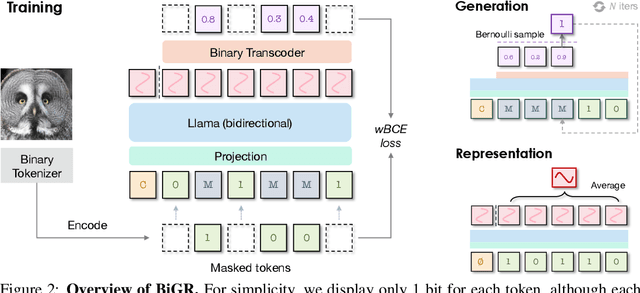
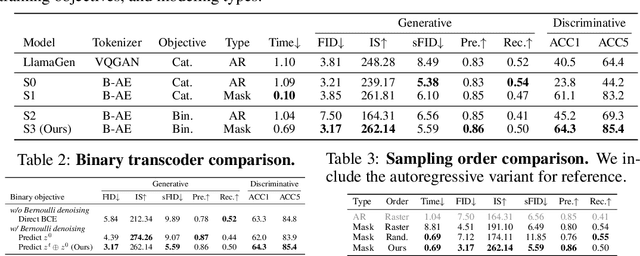


Abstract:We introduce BiGR, a novel conditional image generation model using compact binary latent codes for generative training, focusing on enhancing both generation and representation capabilities. BiGR is the first conditional generative model that unifies generation and discrimination within the same framework. BiGR features a binary tokenizer, a masked modeling mechanism, and a binary transcoder for binary code prediction. Additionally, we introduce a novel entropy-ordered sampling method to enable efficient image generation. Extensive experiments validate BiGR's superior performance in generation quality, as measured by FID-50k, and representation capabilities, as evidenced by linear-probe accuracy. Moreover, BiGR showcases zero-shot generalization across various vision tasks, enabling applications such as image inpainting, outpainting, editing, interpolation, and enrichment, without the need for structural modifications. Our findings suggest that BiGR unifies generative and discriminative tasks effectively, paving the way for further advancements in the field.
ConceptExpress: Harnessing Diffusion Models for Single-image Unsupervised Concept Extraction
Jul 09, 2024



Abstract:While personalized text-to-image generation has enabled the learning of a single concept from multiple images, a more practical yet challenging scenario involves learning multiple concepts within a single image. However, existing works tackling this scenario heavily rely on extensive human annotations. In this paper, we introduce a novel task named Unsupervised Concept Extraction (UCE) that considers an unsupervised setting without any human knowledge of the concepts. Given an image that contains multiple concepts, the task aims to extract and recreate individual concepts solely relying on the existing knowledge from pretrained diffusion models. To achieve this, we present ConceptExpress that tackles UCE by unleashing the inherent capabilities of pretrained diffusion models in two aspects. Specifically, a concept localization approach automatically locates and disentangles salient concepts by leveraging spatial correspondence from diffusion self-attention; and based on the lookup association between a concept and a conceptual token, a concept-wise optimization process learns discriminative tokens that represent each individual concept. Finally, we establish an evaluation protocol tailored for the UCE task. Extensive experiments demonstrate that ConceptExpress is a promising solution to the UCE task. Our code and data are available at: https://github.com/haoosz/ConceptExpress
CoCoCo: Improving Text-Guided Video Inpainting for Better Consistency, Controllability and Compatibility
Mar 18, 2024Abstract:Recent advancements in video generation have been remarkable, yet many existing methods struggle with issues of consistency and poor text-video alignment. Moreover, the field lacks effective techniques for text-guided video inpainting, a stark contrast to the well-explored domain of text-guided image inpainting. To this end, this paper proposes a novel text-guided video inpainting model that achieves better consistency, controllability and compatibility. Specifically, we introduce a simple but efficient motion capture module to preserve motion consistency, and design an instance-aware region selection instead of a random region selection to obtain better textual controllability, and utilize a novel strategy to inject some personalized models into our CoCoCo model and thus obtain better model compatibility. Extensive experiments show that our model can generate high-quality video clips. Meanwhile, our model shows better motion consistency, textual controllability and model compatibility. More details are shown in [cococozibojia.github.io](cococozibojia.github.io).
Bridging Different Language Models and Generative Vision Models for Text-to-Image Generation
Mar 12, 2024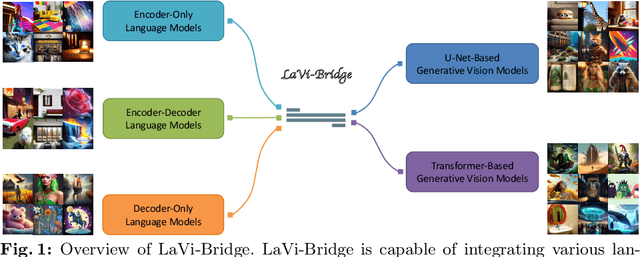
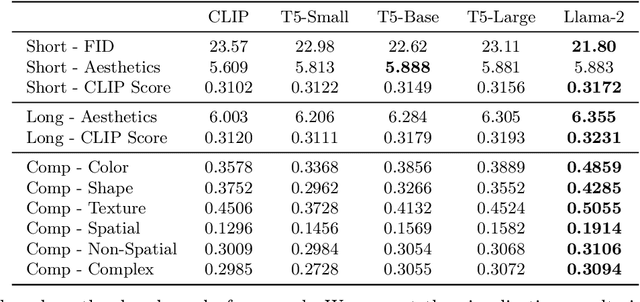
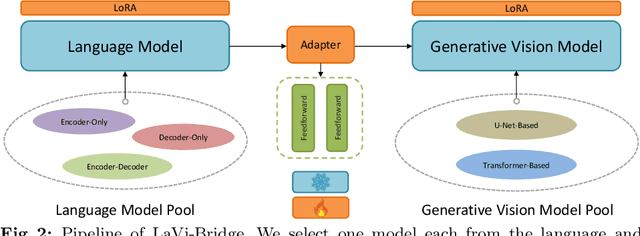
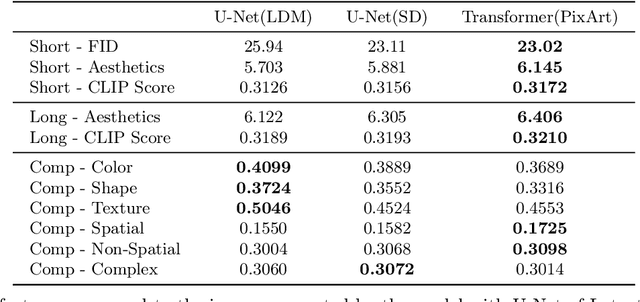
Abstract:Text-to-image generation has made significant advancements with the introduction of text-to-image diffusion models. These models typically consist of a language model that interprets user prompts and a vision model that generates corresponding images. As language and vision models continue to progress in their respective domains, there is a great potential in exploring the replacement of components in text-to-image diffusion models with more advanced counterparts. A broader research objective would therefore be to investigate the integration of any two unrelated language and generative vision models for text-to-image generation. In this paper, we explore this objective and propose LaVi-Bridge, a pipeline that enables the integration of diverse pre-trained language models and generative vision models for text-to-image generation. By leveraging LoRA and adapters, LaVi-Bridge offers a flexible and plug-and-play approach without requiring modifications to the original weights of the language and vision models. Our pipeline is compatible with various language models and generative vision models, accommodating different structures. Within this framework, we demonstrate that incorporating superior modules, such as more advanced language models or generative vision models, results in notable improvements in capabilities like text alignment or image quality. Extensive evaluations have been conducted to verify the effectiveness of LaVi-Bridge. Code is available at https://github.com/ShihaoZhaoZSH/LaVi-Bridge.
ViCo: Detail-Preserving Visual Condition for Personalized Text-to-Image Generation
Jun 01, 2023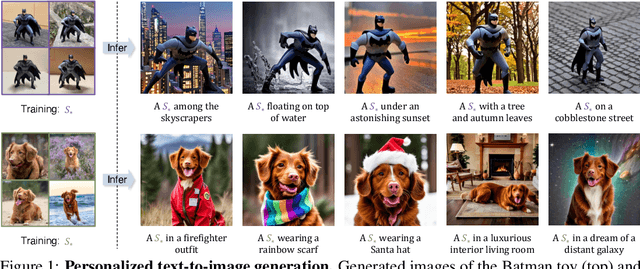

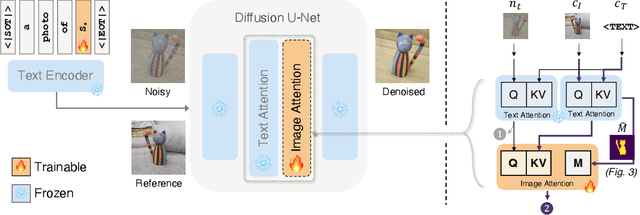

Abstract:Personalized text-to-image generation using diffusion models has recently been proposed and attracted lots of attention. Given a handful of images containing a novel concept (e.g., a unique toy), we aim to tune the generative model to capture fine visual details of the novel concept and generate photorealistic images following a text condition. We present a plug-in method, named ViCo, for fast and lightweight personalized generation. Specifically, we propose an image attention module to condition the diffusion process on the patch-wise visual semantics. We introduce an attention-based object mask that comes almost at no cost from the attention module. In addition, we design a simple regularization based on the intrinsic properties of text-image attention maps to alleviate the common overfitting degradation. Unlike many existing models, our method does not finetune any parameters of the original diffusion model. This allows more flexible and transferable model deployment. With only light parameter training (~6% of the diffusion U-Net), our method achieves comparable or even better performance than all state-of-the-art models both qualitatively and quantitatively.
Uni-ControlNet: All-in-One Control to Text-to-Image Diffusion Models
May 31, 2023Abstract:Text-to-Image diffusion models have made tremendous progress over the past two years, enabling the generation of highly realistic images based on open-domain text descriptions. However, despite their success, text descriptions often struggle to adequately convey detailed controls, even when composed of long and complex texts. Moreover, recent studies have also shown that these models face challenges in understanding such complex texts and generating the corresponding images. Therefore, there is a growing need to enable more control modes beyond text description. In this paper, we introduce Uni-ControlNet, a novel approach that allows for the simultaneous utilization of different local controls (e.g., edge maps, depth map, segmentation masks) and global controls (e.g., CLIP image embeddings) in a flexible and composable manner within one model. Unlike existing methods, Uni-ControlNet only requires the fine-tuning of two additional adapters upon frozen pre-trained text-to-image diffusion models, eliminating the huge cost of training from scratch. Moreover, thanks to some dedicated adapter designs, Uni-ControlNet only necessitates a constant number (i.e., 2) of adapters, regardless of the number of local or global controls used. This not only reduces the fine-tuning costs and model size, making it more suitable for real-world deployment, but also facilitate composability of different conditions. Through both quantitative and qualitative comparisons, Uni-ControlNet demonstrates its superiority over existing methods in terms of controllability, generation quality and composability. Code is available at \url{https://github.com/ShihaoZhaoZSH/Uni-ControlNet}.
Revisiting Adversarial Robustness Distillation: Robust Soft Labels Make Student Better
Aug 18, 2021
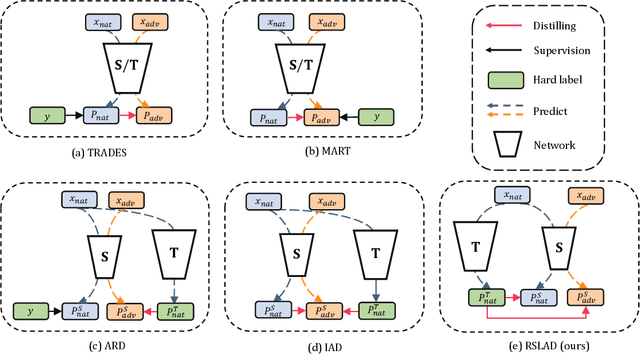

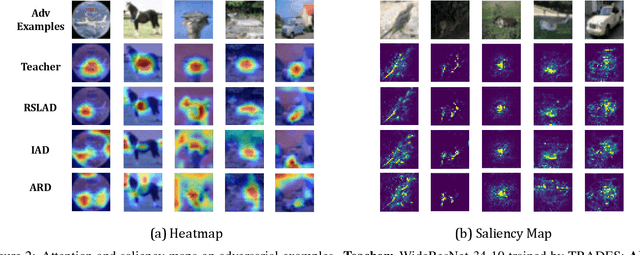
Abstract:Adversarial training is one effective approach for training robust deep neural networks against adversarial attacks. While being able to bring reliable robustness, adversarial training (AT) methods in general favor high capacity models, i.e., the larger the model the better the robustness. This tends to limit their effectiveness on small models, which are more preferable in scenarios where storage or computing resources are very limited (e.g., mobile devices). In this paper, we leverage the concept of knowledge distillation to improve the robustness of small models by distilling from adversarially trained large models. We first revisit several state-of-the-art AT methods from a distillation perspective and identify one common technique that can lead to improved robustness: the use of robust soft labels -- predictions of a robust model. Following this observation, we propose a novel adversarial robustness distillation method called Robust Soft Label Adversarial Distillation (RSLAD) to train robust small student models. RSLAD fully exploits the robust soft labels produced by a robust (adversarially-trained) large teacher model to guide the student's learning on both natural and adversarial examples in all loss terms. We empirically demonstrate the effectiveness of our RSLAD approach over existing adversarial training and distillation methods in improving the robustness of small models against state-of-the-art attacks including the AutoAttack. We also provide a set of understandings on our RSLAD and the importance of robust soft labels for adversarial robustness distillation.
 Add to Chrome
Add to Chrome Add to Firefox
Add to Firefox Add to Edge
Add to Edge